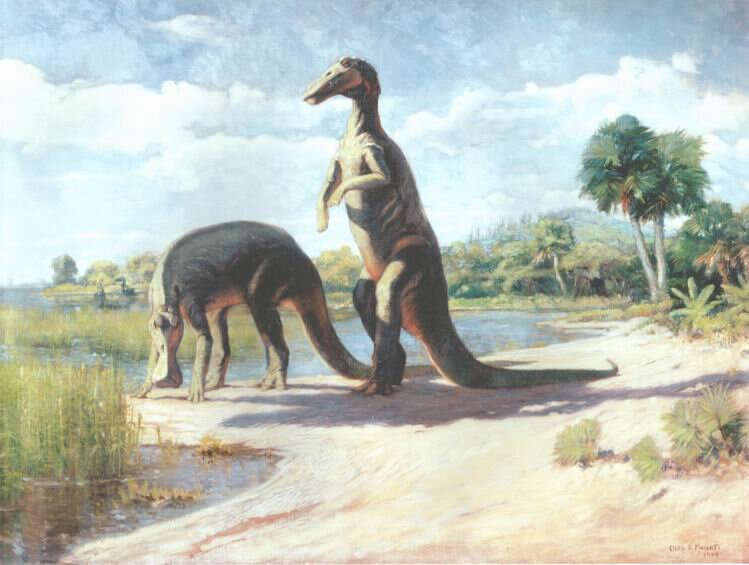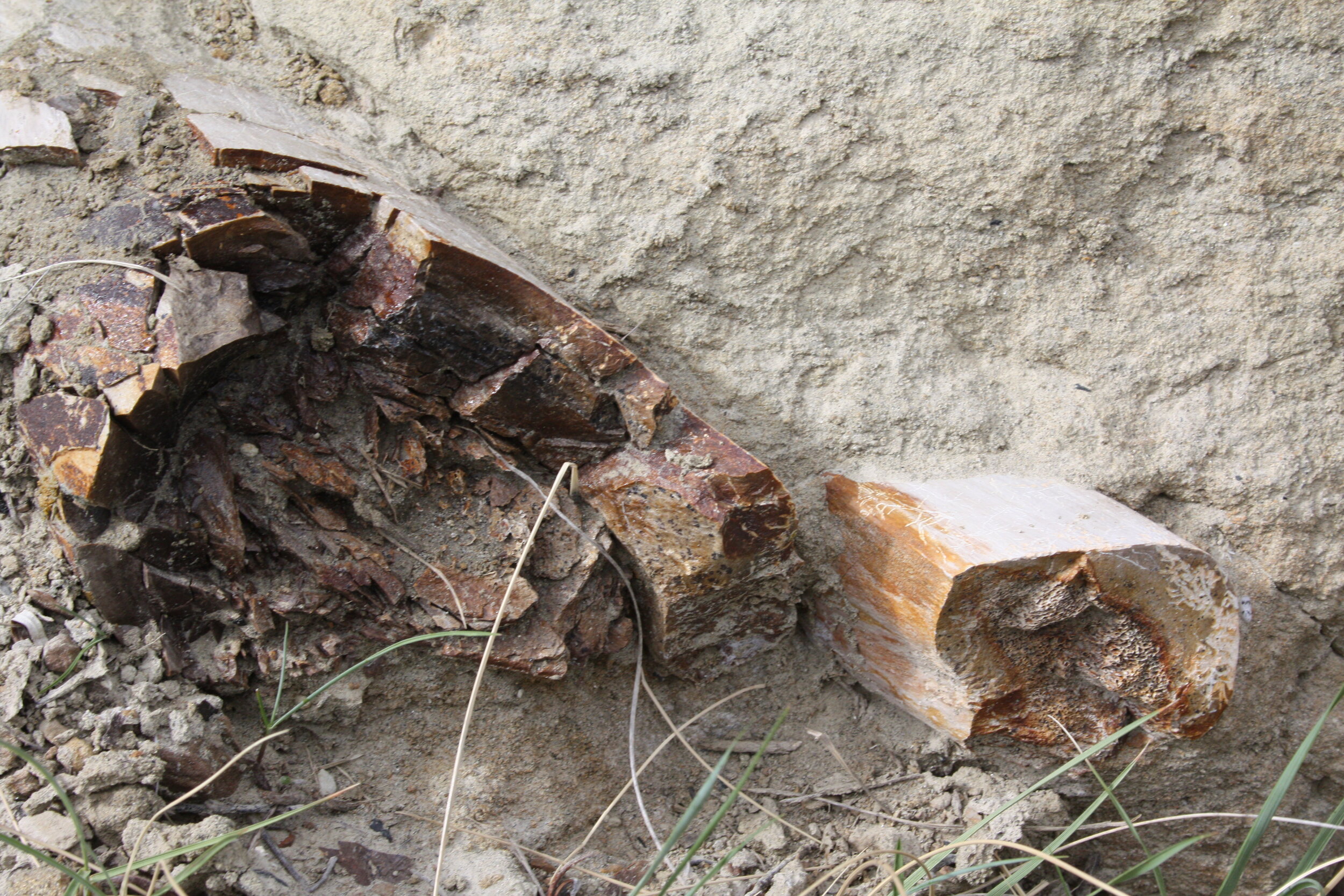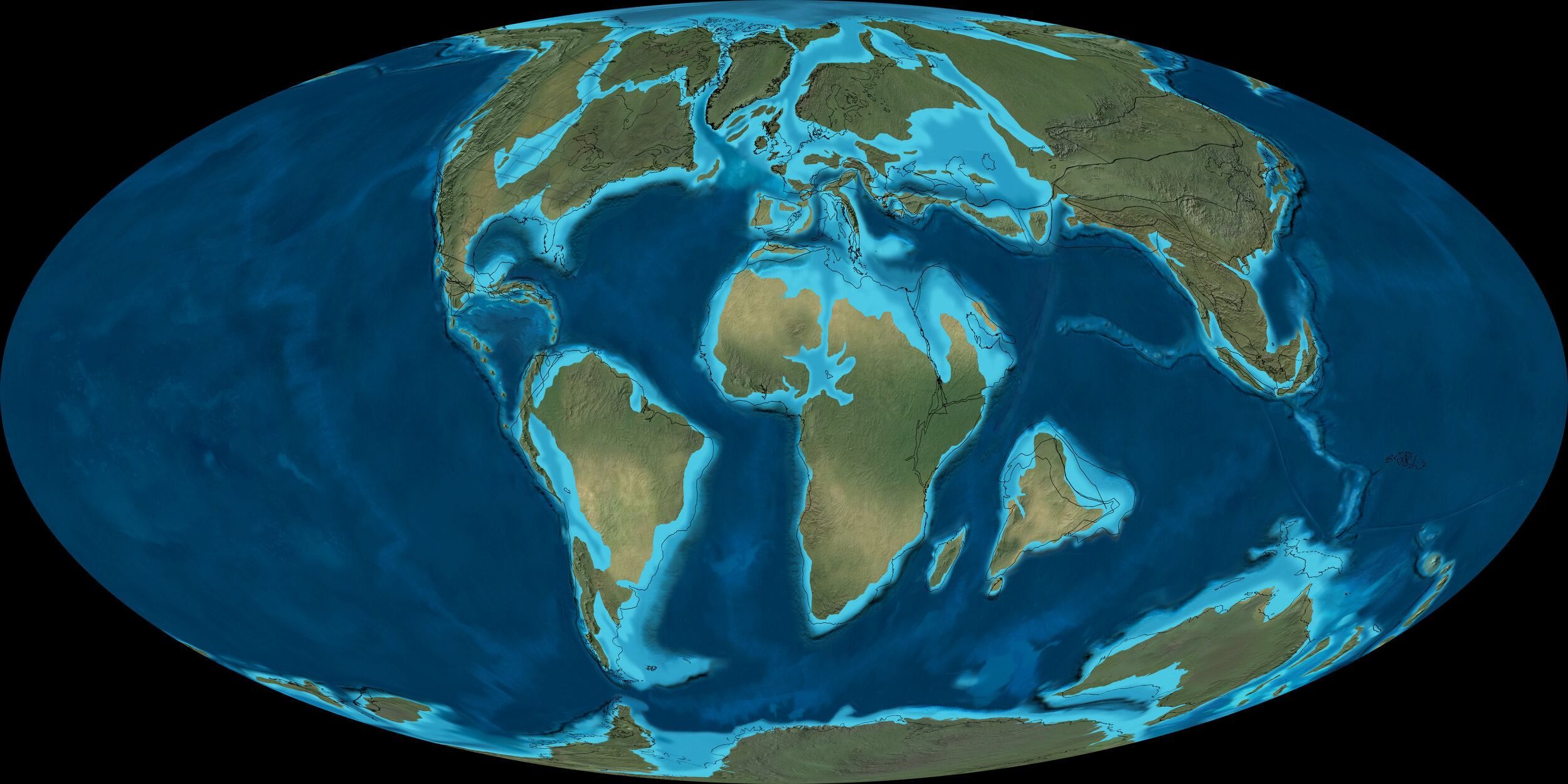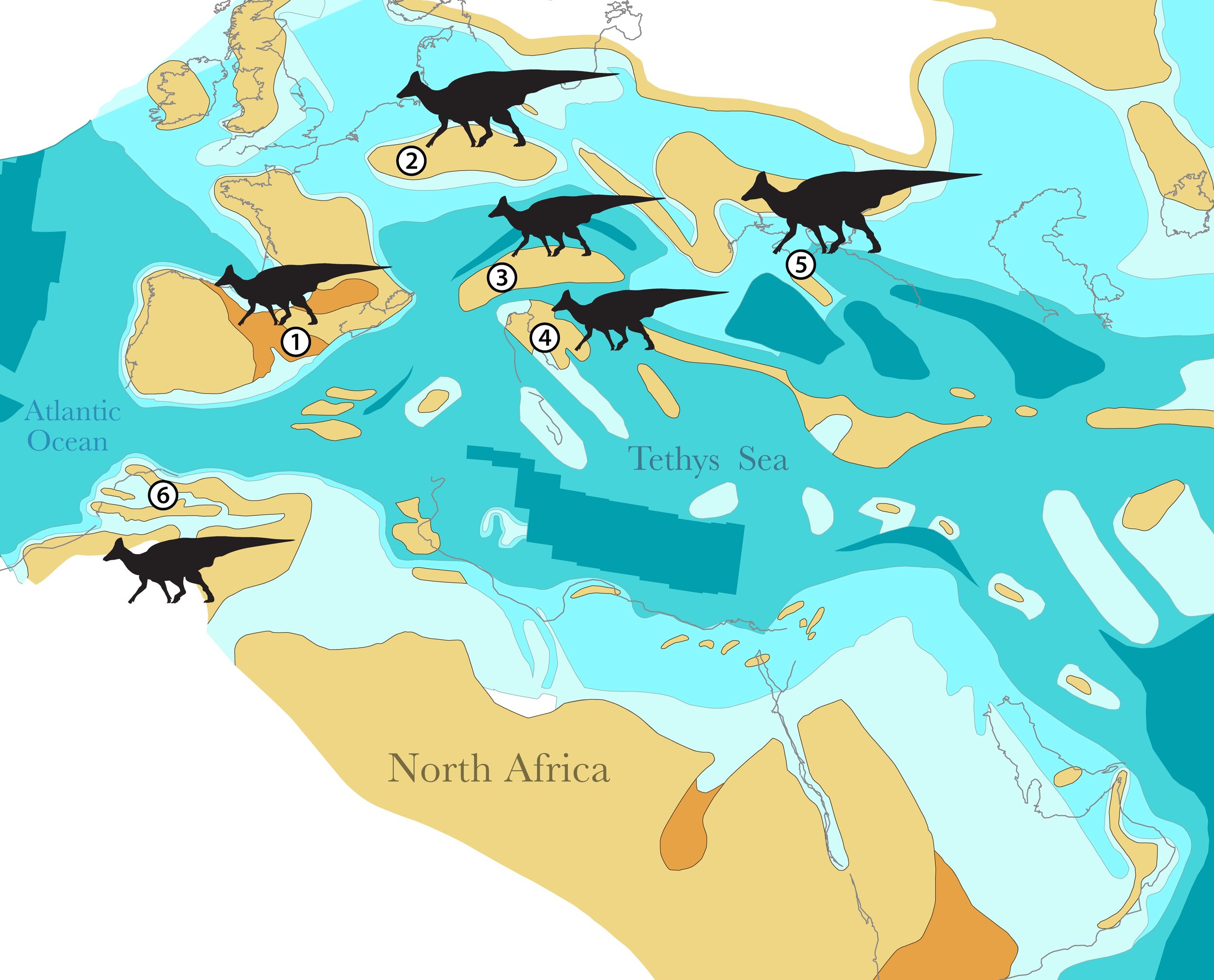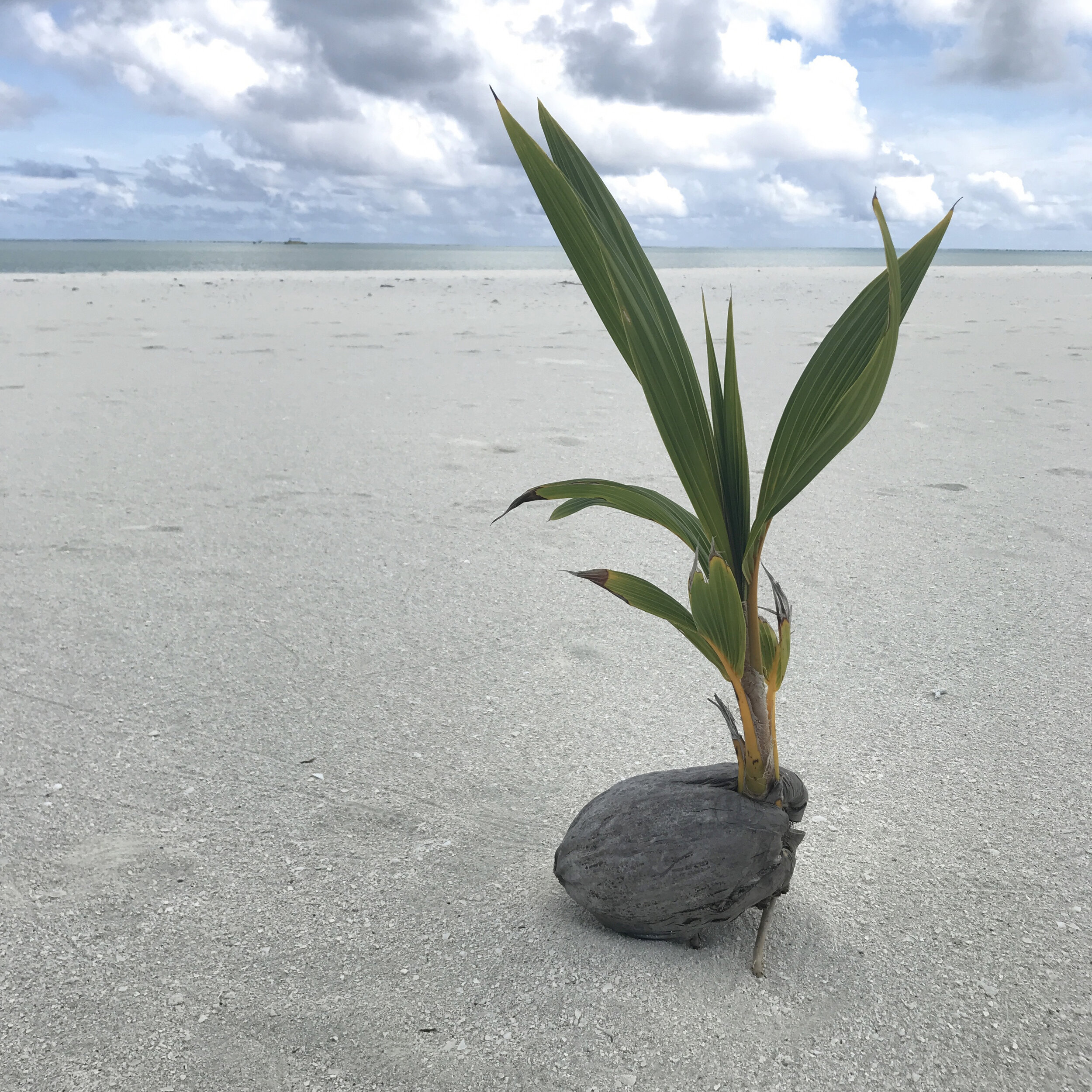Ajnabia odysseus - the first duckbill dinosaur from Africa
Oceanic dinosaur dispersal, and the role of low-probability, high impact events in evolution
by Nick Longrich
Ajnabia odysseus, my little pony-sized duckbill from Morocco (Raul Martin)
It was my first time in the field.
I was in Dinosaur Provincial Park, in Canada, during the first year of my PhD, and I was going to find dinosaurs.
We were coming back from a dig, I glanced up, and I saw a piece of dinosaur sticking out of the sandstone above me. A piece of jawbone, 76 million years old, and in pristine condition. Dozens of teeth duck out of the jaw, their enamel still shiny, slowly freed from the rock by thousands of years of erosion, countless seasons of rain and snows.
A 76- million year old duckbill dinosaur bone slowly weathers out of the ground in Dinosaur Provincial Park, Alberta. (Nick Longrich)
“Look at that!” I said.
To which the leader of the dig said, “yeah, come on Nick. We’re busy, let’s go.”
It was, of course, a duckbill dinosaur. This tells you something about the esteem that duckbills are held in by many paleontologists.
The duckbills were a group of specialized herbivores that evolved at the end of the Cretaceous. As their name suggests, they had a ducklike beak. Behind that beak, they had specialized batteries of teeth- hundreds of teeth packed together, three, four, or even five teeth per socket, forming a complex grinding structure that let them shred tough plants. Duckbills walked on either two or four legs. Some of them had elaborate cranial crests.
The duckbill Anatotitan, from the Latest Cretaceous of North America, 66 MYA. (Charles R. Knight)
But compared to other dinosaurs, duckbills don’t get a lot of love. I think that’s because they’re usually depicted as peaceful herbivores. T. rex is a fearsome predator. Triceratops has these wicked, deadly horns and probably fought T. rex, and each other. Brontosaurus could stomp stuff.
Skulls of a crested duckbill (the lambeosaurine Hypacrosaurus) and a flat-headed duckbill (the hadrosaurine Brachylophosaurus), from the Late Cretaceous of North America. (Nick Longrich)
These are exciting dinosaurs, the stuff Jurassic Park franchises and merchandising are built on. People like stories with conflict, and dinosaurs grab our attention to the extent that they seem dangerous, so we want our dinosaurs to be properly terrifying, to fight and kill.
Duckbills were harmless, peaceful plant-eaters, the stuff the cool dinosaurs eat. They were team players, nerds hanging out in herds.
Few kids pick a duckbill dinosaur as their favorite.
Tibia and fibula of a duckbill dinosaur (Brachylophosaurus?) in the sandstone of the Oldman Formation, Canada. (Nick Longrich)
Here’s the bones in the rock (next to my GPS and climbing axe). It’s under about 10 feet of rock-hard rock. This was 2009 and I doubt it’s gone anywhere since! If you want to go out to the South Saskatchewan river, there’s probably a whole dinosaur under this outcrop! (Nick Longrich)
Plus, they’re just so common in North America. Dubbed the “cows of the Cretaceous” because they’re big, common, boring herbivores, duckbills are everywhere in Dinosaur Provincial Park- dozens of skeletons, some partial, some likely quite complete, are still lying out there in the field.
There’s just far too many duckbills out there to have the time and money to collect them. There’s not enough space in the museums for them all. Nobody is really fighting over who gets to research them, either. So typically, when people find duckbill teeth or bones, they tend to simply be left to weather away.
We saw hundreds of duckbill bones and teeth in the field, if not thousands, over the years… most of them were abandoned. And for all I know, that duckbill jaw in Dinosaur Park is still there- or else, it washed away years ago.
Me and Mohammed in Morocco. If you’re in Morocco and ever forget someone’s name, try Mohammed and you’ll be right about 50% of the time.
Now, cut to Morocco.
A few years ago, I was looking at a collection of fossils in Morocco, and saw something that made me stop cold. It was a duckbill dinosaur jaw, with little teeth in it.
Just like that jaw I saw in Canada as a student.
The Moroccan duckbill jaw. Longrich et al., 2021
Now, some finds leave you scratching your head, or consulting papers and photographs, until you have that eureka! moment. But this wasn’t like that.
I took one look, saw the distinctive teeth, and thought: duckbill dinosaur. God knows, I’d seen enough of the damn things in the field, and in the collections over the years. I’d learned to recognize duckbills not because I was interested in researching them, but just because knowing a fossil came from a duckbill helped me establish that the fossil at hand was not worth further study, allowing me move on to something that was interesting and research-worthy and very non-duckbill.
So I had a duckbill. The only problem was, that really shouldn’t be possible.
The distinctive teeth of a duckbill, seen here in Ajnabia. Hundreds of these were packed together to make complex grinding surfaces, with teeth constantly worn down, shed, and replaced. (Longrich et al., 2021)
Here’s why. Millions of years ago, at the start of the Jurassic, all the continents were joined together into a vast supercontinent, called Pangaea.
Pangaea, during the Jurassic- 200 MYA (R. Blakey)
At the start of the Jurassic, Pangaea starts to break up. By 90 million years ago, when the duckbills first evolved in North America, the breakup was finished- and Africa was completely isolated from the rest of the world by ocean.
So by the time duckbills evolved, there was just no way for them to get to Africa. And up until now, what we’d seen from Morocco were classic African dinosaurs- stuff like the abelisaur Chenanisaurus, and titanosaurs, groups which evolved and spread in the continents of the Southern Hemisphere, the landmasses of the supercontinent Gondwana. So my assumption had been that future finds from Africa would be related to stuff seen in these Gondwanan continents- Africa, South America, India, Australia.
Late Cretaceous map, 70 MYA. Africa is an island. How to get there? (R. Blakey)
And now we had this improbable duckbill. What ‘s up with that?
Suddenly, duckbills became really interesting.
Now, one lineage of duckbill did get into western Gondwana, in South America. These duckbills were related to North American duckbills like Kritosaurus, which are part of the flat-headed Hadrosaurinae. But close study of the teeth and jaw of our Moroccan thing suggested it wasn’t part of this group. Instead, it was more closely related to European duckbills, like Arenysaurus, which are part of the crested duckbills, the Lambeosaurinae.
Trying to piece together the puzzle, it seemed our Moroccan duckbill was closely related to these European species, which were in turn part of the Lambeosaurinae- a group that originates in Asia.
This suggested a pattern where duckbills first evolved in North America, then migrated to Asia, then to Europe, and finally, Morocco. The problem? To do this, they had to cross water.
Africa would have been several hundred kilometers from the Iberian Peninsula when this dispersal event happened (assuming they took this route). And Europe was itself a series of small islands at the time, isolated from Asia by the Turgai Strait. How was that possible? Did they cross water- and if so, how the heck did they do that?
Map showing the distribution of duckbills in Europe and North Africa during the Late Cretaceous (Longrich et al., 2021)
The idea of oceanic dispersal goes back to the origins of evolutionary theory. Darwin, studying the Galapagos, reasoned that the reason that turtles and lizards dominated the Galapagos Islands was that they were somehow able to survive weeks at sea- floating (in the case of tortoises) or rafting on vegetation (as in the case of the lizards) from the mainland.
Now, reptiles could survive long periods at sea with no food or water- Darwin would have known this, because he and the crew of the Beagle took turtles from the Galapagos and threw them in the hold, alive with no food or water. There they remained until, many weeks later, they were cooked up and eaten. Meanwhile, Darwin and his fellow mammals required fresh water and food every day or they’d die of dehydration and starvation quickly. Darwin reasoned that if things drifted across the ocean from the mainland, that would explain why reptiles dominated in the Galapagos- and why farther out in the Pacific, there were not even iguanas or turtles on the little islands and atolls.
Darwin spent a lot of time working out how things could fly and float from mainlands to oceans, and it was central to his theory of evolution, and forcing him to reject creationism (after all, if God made everything, why didn’t God just make rabbits and deer and other mammals in the Galapagos, instead of turtles and iguanas?).
The oceanic dispersal ideas of Darwin fell out of favor to a degree after the discovery of continental drift. The reasoning went that if the continents were all connected long ago, maybe things walked from place to place prior to breakup, and then they simply drifted along with the plates. It’s intuitive, and seems to eliminate all these highly improbable long-distance ocean crossings.
The problem is that continental breakup began so long ago- in the Jurassic- long before modern birds and mammals evolved- and even long before groups like duckbills and titanosaurian sauropods diversified. Even by the time of the dinosaurs, stuff had been isolated for a very long time.
So what’s going on?
Well, as Sherlock Holmes said, eliminate the impossible, and whatever remains, no matter how improbable, must be the truth.
The duckbills couldn’t walk to Africa. There were no land bridges- Africa was separated by deep ocean channel, even when sea levels were lower. Continental drift couldn’t explain how they got there- Africa separated from Europe and Asia long before duckbills had even evolved. So they had to cross water. But how?
It turns out, many large mammals actually swim relatively well. Deer for example can swim up to 5 km in the ocean to reach islands, and up to 25 km in lakes to forage on islands. Elephants are incredible swimmers. They can swim at almost 3 km per hour for distances approaching 50 km. Remarkably, polar bears can swim hundreds of kilometers, with relatively modest specializations for aquatic life. The record is a 9 day, 687 km (!) swim through open water- which was apparently done without sleeping. Even humans, not particularly good swimmers, can go long distances- the record is 225 km (140 miles), set by one Veljko Rogosic of Croatia, who took 50 hours, 10 minutes.
So animals can swim long distances in the ocean.
And fossils suggest that in the past, they did. A number of oceanic islands in the Mediterranean- never connected to the mainland- had mammal faunas. In the Pleistocene, elephants colonized Crete, Cyprus and Sardinia in the Mediterranean (and also the Channel Islands in California). Deer colonized Crete and Sardinia.
The duckbill Edmontosaurus (Charles R. Knight)
And duckbills were probably far better swimmers than most mammals.
The idea that dinosaurs were highly aquatic, supporting their bulk with water, largely went out with the discovery that dinosaurs were actually well-adapted to support themselves on land, with huge, pillar-like legs like elephants. Still, even if duckbills didn’t spend all their time in the water, some species may have liked to swim, like modern moose and water buffalo. Their big, broad feet, powerful hindlimbs, and deep tails probably made them powerful swimmers. What’s more, the weather was quite balmy in the Cretaceous. Today, many of the world’s oceans are cool, so spending long times at sea you risk hypothermia- in Alaska, for example a person will suffer hypothermia and drown after 30-60 minutes in the North Pacific (something we were very conscious of working on the fishing boats there). In the warm Cretaceous, many oceans may have been warm, like taking a bath, so this may have been less of a constraint, even at higher latitudes.
Animals don’t necessarily have to swim, however. They can also drift passively. Some organisms float pretty well. Tortoises, for example. One tortoise washed up on the shore of Africa after drifting from Aldabra- over 700 km (400 miles) away. The tortoise washed up covered in barnacles, it had been at sea so long- yet, remarkably, alive.
This Aldabra tortoise was at sea so long, barnacles grew on his legs.
This probably explains how tortoises colonized islands like Aldabra, Comoros, Mauritius, Madagascar, and also the Galapagos.
Hippos spend a lot of time in water but apparently aren’t very good swimmers (they mostly run along the bottom) so drifting may explain how hippos ended up going from Africa to Madagascar, and to Crete and Cyprus. Crocodiles also went from Africa to Madagascar, and from Africa to South America, and they spread from Asia into Australia. While crocodiles swim well, they aren’t designed to swim long distances. Instead, they probably drifted passively, floating like logs, on the currents.
Then, we have natural rafts. Sometimes, organisms are swept out to sea on logs, or on natural rafts formed of tangles of vegetation and debris. Rarely, floating islands have been observed- whole stands of trees, roots, soil and all, ripped up by floods and washed out to sea. And very large rafts of vegetation- 10 or 60 or more meters across- sometimes are seen washed out to sea, and could conceivably carry populations long distances.
This might sound speculative, but in fact rafting has been observed in nature. In 1995, following a hurricane, a group of iguanas washed up on Anguilla on debris, apparently coming from Guadeloupe, around 200 km (70 miles) away.
Rafting probably explains how iguanas got to the Galapagos- and also the truly bizarre appearance of iguanas in Fiji, around 11,000 km (7000 miles) away from where iguanas evolved, in the Americas.
Rafting probably explains the origins of Madagascar’s mammal fauna- lemurs, tenrecs, fossa must all have rafted the Mozambique channel. Several South American mammal groups- monkeys, rodents- that have close relatives living in Africa must have rafted to South America across the Atlantic. And one group of rodents managed to cross from Asia to Australia, and must have done so by rafting.
All of these continents were isolated by water at the time these colonizations took place, so the only viable explanation is that the animals floated there.
Coconuts float long distances between distant shores. Aitutaki, Cook Islands (Nick Longrich)
So swimming, drifting, or rafting, could explain how duckbills got Africa.
But is it really likely that duckbills crossed hundreds of kilometers of open ocean, until they reached Europe, then Africa? Not likely, no. It’s incredibly unlikely.
We just don’t, for the time being, have a better idea. The duckbills emerged too late for continental drift to come to our rescue as an explanation; the various continents had parted ways millions of years before.
And there’s no geological evidence - or biological evidence- for land bridges. Land bridges have a very distinctive biogeographic signal. Once you remove barriers, things stream back and forth across them like theres… well, no barrier. The ancient Bering Land Bridge between North America and Asia, for example, meant that in the Cretaceous many kinds of dinosaurs- tyrannosaurids, ornithomimids, oviraptorosaurs, ankylosaurs, ceratopsids, leptoceratopsids- are found on either side of that land bridge- along with both lambeosaurine and hadrosaurine duckbills. As a result you very closely related dinosaur species in Montana and Mongolia.
Likewise, when North America and South America collided a few million years ago, mammals streamed across in both directions. North Amerian stuff- horses, tapirs, gomphotheres, peccaries, deer, camels, mustelids, racoons, dogs, cats, rabbits, squirrels, pocket gophers- moved south. Meanwhile, southern mammals- opossums, armadillos, ground sloths, anteaters, toxodonts, caviimorph rodents, phorusrhacid terror birds- moved North. We don’t see this with Africa and Europe or Asia in the Mesozoic, so a land bridge seems unlikely.
But what’s really interesting is that the African duckbills aren’t the only probable example of a long-distance, overwater dispersal by dinosaurs. A number of lineages show similar patterns- suddenly showing up where they really have no right to be.
In the latest Cretaceous, a different group of duckbills, the kritosaurs, somehow managed to get to South America, even though (as far as we know) there’s no land bridge. Several duckbills also crossed the Western Interior Seaway to go from western North America to eastern North America.
Meanwhile, the titanosaur Alamosaurus shows up in Texas around the same time, from South America. But we’re not seeing a wholesale swapping of species, so it’s unlikely they used a land bridge; they apparently crossed the water.
In other places, we see dinosaurs from Europe end up in Asia, and vice versa.
Possible ocean crossings by dinosaurs in the Late Cretaceous. Longrich et al., 2021.
Titanosaurs seem really interesting. Did they swim? Maybe. Large animals seem to swim better than small ones (remember those elephants). But I suspect they may have, counterintuitively, floated really well.
The ability to float isn’t affected by somethings weight, but rather, by its density. A small stone doesn’t weigh much, but it sinks, a huge iceberg might weigh a billion tons, but since it’s less dense than water, it floats. And while giant titanosaurs were heavy, they probably weren’t that dense.
Although the limb bones of titanosaurs were massive, their vertebrae were hollow and air-filled, like bird’s bones, to reduce the strain their massive weight placed on their skeleton. This meant they must have been fairly buoyant. And what’s more, the air filled neck and back would have helped keep them bobbing upright- giving them a low center of gravity relative to their center of buoyancy. The entire neck would have been filled with air sacs to the point that it would have been almost impossible to push under the water, like a giant pool noodle. So titanosaurs may have been self-righting like a ship or a floating oil rig, their heavy feet and legs acting like ballast, automatically floating upright even in rough seas.
And even if they fell asleep or lost consciousness, the air-filled neck would have kept the head free of the water- just like the collar of an inflatable life vest is designed to keep a shipwreck survivor’s head out of the water as they float at sea. With their massive bodies titanosaurs could have easily gone weeks or months at sea without food- like drifting tortoises. The main constraint would have been water. Elephants can last for a few days without water (4, according to my highly scientific Google search) but if sauropods were more like turtles in this respect, it’s conceivable they could have lasted much longer at sea.
I appreciate the idea of giant sauropods, bobbing along on the waves, might strike some as implausible. And it is. I just don’t have a better, less-implausible explanation.
Could I be wrong about all this? Absolutely.
Maybe we will revise the geology, and find there were land bridges at some point. But I think it’s worth throwing out there, and so far, I haven’t seen people talking about this- it’s well known that stuff moved around in the Late Cretaceous, but what’s rarely talked about is how. That sort of gets glossed over, but it’s a non-trivial problem.
So why do we care, if dinosaurs did cross oceans?
The reason I think it matters is that it shows how rare events can never the less have a big impact on evolution. It gets back to the idea of improbability versus impossibility. Forced to choose between things that are as far as we know, impossibilities (land bridges, continental drift, flying pegasus-unicorns transporting duckbills and other dinosaurs) we must choose improbabilities (swimming, floating, rafting).
But improbable may not be all that improbable. Over huge periods of time, some improbable things become highly probable. We humans live such short, brief lives- barely a century, if we’re lucky, often less than that. In these ephemeral lives, highly improbable events- shark attacks, lightning strikes, winning the lottery- are unlikely to affect us.
But over vast spans of time, rare events become probable. If we could live for tens of millions of years, we would get attacked by sharks, struck by lightning, win the lottery many times- these things would be almost guaranteed to happen.
Deep time functions as a sort of infinite improbability drive- given vast spans of time (and a huge, possibly infinite universe) crazy stuff will happen. One-in-a-million year events will happen on average (duh) once every million years. And once-in-100-million, or even once-in-a-billion-year events will tend to happen over these time frames. Humans, for example- we might be one of those incredibly rare events.
Darwin tried to explain evolution by invoking everyday processes- competition, predation, mate choice, that sort of thing, processes he could see in his garden, or on his nature walks. And obviously, given huge periods of time, incremental changes caused by these everyday processes can cause huge amounts of evolution. Just like the slow action of wind and water can wash that duckbill jaw out of the rock in Dinosaur Park- or level entire mountains.
But given enough time, and enough space, and crazily improbable things, rare events play a role. Maybe not all that often, but it can make a difference- after all, you’re unlikely to win the lottery (or get bit by a shark) tomorrow, but if it did, your whole life would change forever.
Some of these are destructive events- catastrophes like volcanic eruptions, severe ice ages, asteroid impacts. Or, say a virus getting lucky and jumping from one species to another.
But some of these improbable occurrences are creative events in the sense that they lead to new things, serendipitous happenings- a gene randomly jumping from one species to another, a genome duplication, an improbable mutation or a series of improbable mutations leading to a complex adaptation… or a dinosaur somehow drifting out to sea and washing up on another continent.
Last, the duckbill.
The African duckbill Ajnabia odysseus compared to other dinosaurs from the late Maastrichtian of Morocco, with a human for scale. (Longrich et al., 2021)
Unfortunately, we don’t have a lot of this animal- just a maxilla, a few scraps of the other maxilla, and a chunk of the dentary. So we don’t know a lot about what it looked like except it was a crested duckbill, similar to animals like Corythosaurus and Hypacrosaurus, and may have been similar.
The one really cool thing we do know is that it seems to be really tiny! The bone does not to my eye look like it’s a juvenile- juveniles typically have a highly vascularized bone texture, where it’s rich with blood vessels to nourish the growing bone tissue. This texture is fairly dense. But the animal was maybe about 3 meters long. That’s tiny by duckbill standards- maybe the size of a pony.
So it might be the smallest duckbill.
As for the name, we named it Ajnabia odysseus. Ajnabi is the Arabic word for “foreigner” or “stranger” and refers to how duckbill dinosaurs arrived as foreigners to Africa. Odysseus of course refers to the mythical Greek hero and seafarer, who made a journey much like that of our dinosaur; he would have started in Europe and then made landfall in North Africa, in the Land of the Lotus-Eaters. The name is therefore a shout-out to both Europe and North Africa, and I like the way it mixes the cultural influences, in that historically Morocco- and for that matter the entire Mediterranean region- have been defined by exchange of peoples and ideas, rather than existing in isolation. I think our history relies far more on such exchanges than we realize- more on that, perhaps, in a future essay.
References
Adams, D., 1979. The Hitchhiker’s Guide to the Galaxy. London, Pan.
Censky, E.J., Hodge, K., Dudley, J., 1998. Over-water dispersal of lizards due to hurricanes. Nature 395, 556.
Longrich, N.R., Pereda-Suberbiola, X., Pyron, R.A., Jalil, N.-E., 2020. The first duckbill dinosaur (Hadrosauridae: Lambeosaurinae) from Africa and the role of oceanic dispersal in dinosaur biogeography. Cretaceous Research, 104678.
Longrich, N.R., Pereda-Suberbiola, X., Jalil, N.-E., Khaldoune, F., Jourani, E., 2017. An abelisaurid from the latest Cretaceous (late Maastrichtian) of Morocco, North Africa. Cretaceous Research 76, 40-52.
Gerlach, J., Muir, C., Richmond, M.D., 2006. The first substantiated case of trans‐oceanic tortoise dispersal. Journal of Natural History 40, 2403-2408.
Pereda-Suberbiola, X., Bardet, N., Iarochène, M., Bouya, B., Amaghzaz, M., 2004. The first record of a sauropod dinosaur from the Late Cretaceous phosphates of Morocco. Journal of African Earth Sciences 40, 81-88.
De Queiroz, A., 2005. The resurrection of oceanic dispersal in historical biogeography. Trends in Ecology & Evolution 20, 68-73.
De Queiroz, A., 2014. The monkey's voyage: how improbable journeys shaped the history of life. Basic Books (AZ).
Links
Wikipedia article on Ajnabia
Media
Eurekalert. The first duckbill dinosaur fossil from Africa hints at how dinosaurs once crossed oceans.
Scientific American. Duckbill Dino Odyssey Ended in Africa
The Times. Duck-billed dinosaur ‘swam across sea’ to Africa.


